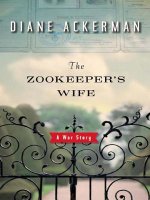The Zookeeper’s Wife:
A War Story
by Diane Ackerman
The Zookeeper’s Wife: A War Story by Diane Ackerman is the historical narrative of Christian Polish zookeepers, Jan Zabinski, a trained zoologist and the director of the Warsaw zoo, and his wife, Antonina. Taken primarily from the memoirs, diaries, and autobiographical children’s books of Antonina, Ackerman has produced a book that squarely faces the horror of Hitler’s plans to destroy every aspect of Poland’s multi-faceted identity. Within this crucible of malevolence, the Zabinskis took great risks to save hundreds of Jews during World War II. The author chose to write about the Zabinskis to honor their great heroism during the Nazi regime in Poland “…when even handing a thirsty Jew a cup of water was punishable by death.” Although the action of the story is carried out primarily through Jan, the lens through which we view the action is Antonina’s.
Starting in 1931 the Zabinskis lived in a villa in Praga, just outside Warsaw, not far from the zoo. At their villa they kept a number of injured or orphaned zoo animals and allowed the creatures to roam freely about their residence. This was not simply a necessity due to the care that some of the animals required, it was a scientific approach for Jan. Ackerman records this comment by Jan: “It’s not enough to do research from a distance. It’s by living beside animals that you learn their behaviors and psychology.” As for Antonina, this was a lifestyle that she also relished. An “animal whisperer” before anyone heard of the term, Antonina had, according to her husband’s notes, had an “uncanny ability to calm unruly animals.”
From their home in Praga the Zabinskis could see the rooftops of the Old Town of Warsaw. Just outside the Old Town lay the large Jewish Quarter with a population of about 300,000 Jews, which, says Ackerman, was “the heartbeat of eastern European Jewish culture.” The Jews who lived in the Jewish Quarter maintained their own style of dress, culture, language and religion and many spoke no Polish, according to Ackerman.
Rumors of war were everywhere in Warsaw in the summer of 1939, and they proved to be prophetic. On September 1, Hitler invaded Poland. On September 7, forty-two year old Jan was formally ordered to join the Polish army at the front, and all civilians were directed to vacate the zoo at once. Antonina took their young son, Rys, and sought refuge where she could in Warsaw as the Germans began 1,150 bombing sorties over the city.
During the bombings, concerns about the animals eventually caused Antonina and a few keepers to go to the zoo to assess the damage, which they found to be extensive. Many animals were killed and buildings were destroyed by bullets, bombs and fire. Some animals escaped and entered the Old Town while Warsaw was in flames. “People brave enough to stand by their windows…watched a biblical hallucination unfolding as the zoo emptied into Warsaw streets,” writes Ackerman.
Poland soon surrendered to Hitler and what was left of Jan’s military contingent left the front to return to their homes. In an astonishing story that verges on the miraculous, Jan was reunited with Antonina and Rys at his sister’s apartment in Warsaw. After a brief stay in the city the little family walked back to their damaged villa to resume caring for the zoo and its remaining animals.
Ackerman writes that “Under the Third Reich, animals became noble, mythic, almost angelic — including humans of course, but not Slavs, Gypsies, Catholics or Jews.” Laws were soon in place for the elimination of these “sub-human” specimens. As Hitler’s plans for the destruction of Poland and its people unfolded, the liquidation of the Warsaw zoo also became a reality. Though devastated by the Reich’s decision, Jan saw an opportunity and convinced director Lutz Heck, a powerful Nazi leader and a zoologist, to use the old zoo buildings as a large pig farm. Ackerman records this: “According to testimony [Jan] gave to the Jewish Historical Institute in Warsaw, by using the ruse of gathering scraps for feeding pigs, he hoped to ‘bring notes, bacon, and butter and carry messages for friends in the Ghetto.” This was only one of the ways that the Zabinskis helped the Jews during the war.
Other resistance activities included the incredible risk of hiding an ammunition dump for the Polish Home Army in the middle of the zoo. About this, Ackerman writes: “As Jan thought, it never occurred to the Germans that a Pole would be that gutsy, because they regarded Slavs as a fainthearted and stupid race fit only for physical labor.”
When it came to hiding refugees, the zoo was by no means the ideal location says Ackerman. “The villa stood close to Ratuszowa Street, right out in the open like a lighthouse, surrounded only by cages and habitats.” But the Zabinskis took in many “guests,” approximately three hundred, whom they hid either in the villa or on the zoo’s property as the refugees passed through to their final destinations.
Why did the Zabinskis take the tremendous risk of rescuing Jews during the war? Ackerman has this answer from an interview conducted with Jan by reporter Noah Kliger of the Israeli newspaper, Yediot Aharonot: “I only did my duty — if you can save somebody’s life, it’s your duty to try.”
I hope you find time to read A War Story: The Zookeeper’s Wife, by Diane Ackerman. That it can be seen as a modern type of the story of Noah’s ark adds an additional level of amazement. Jan and Antonina Zabinski were named by Yad Vashem as Righteous Among the Nations in 1965.

